Maison >Java >javaDidacticiel >Comment écrire des cas de test en Java
Comment écrire des cas de test en Java
- WBOYWBOYWBOYWBOYWBOYWBOYWBOYWBOYWBOYWBOYWBOYWBOYWBoriginal
- 2024-08-12 18:40:36794parcourir
La rédaction de cas de tests est une compétence fondamentale pour garantir la fiabilité et la robustesse de votre code. Les cas de test peuvent aider à identifier les bogues et à valider que le code fonctionne comme prévu.
Les cas de test peuvent être écrits à l'aide de n'importe quel langage de programmation comme Java, Python, C#, etc. Cependant, de nombreux testeurs préfèrent écrire des cas de test en Java en raison de son fort soutien communautaire et de son alignement avec les besoins du projet. L'automatisation de ces cas de test en Java aide les testeurs à gagner du temps d'exécution et à détecter les erreurs dès les premières étapes des tests.
Qu’est-ce qu’un scénario de test en Java ?
Java est l'un des langages de programmation les plus utilisés pour les tests d'automatisation. Écrire un scénario de test en Java signifie créer un projet d'automatisation complet qui suit et implémente les concepts de POO. Cela rend le projet et le scénario de test plus robustes, et l'ensemble du code est classé en de nombreuses classes et méthodes, ce qui le rend plus maintenable et facile à utiliser.
Les cas de test automatisés permettent de tester rapidement la fonctionnalité en cas de régression et permettent d'économiser beaucoup d'efforts manuels. Ces cas de test exécutent un flux sur la page Web, puis utilisent des assertions pour vérifier si la sortie correspond à la sortie souhaitée.
Par exemple, pour la section Deux champs de saisie de la page LambdaTest Selenium Playground, quelques-uns des cas de test ressembleraient à ce qui suit :
- Vérifiez que toutes les étiquettes, zones de saisie de texte et boutons sont présents sur la page.

- Vérifiez que la somme s'affiche correctement sous Résultat lors de la saisie des deux nombres.

- Vérifiez que le message d'erreur s'affiche sous Résultat si un ou les deux chiffres ne sont pas saisis.

Lors de l'écriture de cas de test en Java, plusieurs éléments doivent être pris en compte, comme le flux de test, la portée du test, la dénomination, les assertions, les données de test, le regroupement, la localisation des WebElements, etc. Lorsqu'ils sont utilisés avec précision, tous ces éléments constituent un bon test cas facile à comprendre et à maintenir à l'avenir à mesure que d'autres changements surviennent.
Cependant, l'action initiale pour démarrer le flux de test consiste à localiser un WebElement pour lequel vous devez écrire un scénario de test efficace en Java.
Localisation des WebElements en Java
Une autre chose à apprendre sur l'écriture de cas de test en Java est de localiser les WebElements. Ceci est nécessaire car le flux du scénario de test interagira avec ces WebElements pour effectuer des actions telles que saisir des données, cliquer sur un bouton, récupérer des données, etc., pour obtenir les résultats. Il existe plusieurs façons de trouver les localisateurs WebElement dans Selenium, tels que ID, Name, CSS, XPath, linkText, etc.
Avant de montrer comment écrire des cas de test en Java, apprenons comment différents WebElements utilisés dans le flux de test peuvent être localisés à l'aide de leurs stratégies de localisation. Nous utiliserons les localisateurs XPath ou ID pour localiser tous les WebElements pour ce cas de test.
Vous pouvez utiliser l'une des méthodes les plus courantes pour rechercher des éléments, c'est-à-dire findElement() dans Selenium.

- Pour localiser l'étiquette Deux champs de saisie de la page LambdaTest Selenium Playground à l'aide de XPath, vous pouvez utiliser l'expression XPath suivante :
driver.findElement(By.xpath("//*[contains(text(),'Two')]"));
- Pour localiser l'étiquette Entrer la première valeur de la page LambdaTest Selenium Playground à l'aide de XPath, vous pouvez utiliser l'expression XPath suivante :
driver.findElement(By.xpath("//*[contains(text(),'first value')]"));
- Pour localiser l'étiquette Entrer la deuxième valeur sur la page LambdaTest Selenium Playground à l'aide de XPath, vous pouvez utiliser l'expression XPath suivante :
driver.findElement(By.xpath("//*[contains(text(),'first value')]"));
- Pour localiser le bouton Obtenir la somme de la page LambdaTest Selenium Playground à l'aide de XPath, vous pouvez utiliser l'expression XPath suivante :
driver.findElement(By.xpath("//*[contains(text(),'Sum')]"));
- Pour localiser la zone de texte Première valeur de la page LambdaTest Selenium Playground à l'aide de l'ID, vous pouvez utiliser l'expression d'ID suivante :
driver.findElement(By.id("sum1"));
- Pour localiser la zone de texte Deuxième valeur de la page LambdaTest Selenium Playground à l'aide de l'ID, vous pouvez utiliser l'expression d'ID suivante :
driver.findElement(By.id("sum2"));
- Pour localiser l'étiquette Résultat de la page LambdaTest Selenium Playground à l'aide de l'ID, vous pouvez utiliser l'expression d'ID suivante :
driver.findElement(By.id("user-message"));
- Pour localiser le Message de résultat/erreur de la page LambdaTest Selenium Playground à l'aide de l'ID, vous pouvez utiliser l'expression d'ID suivante :
driver.findElement(By.id("addmessage"));
Vous pouvez également vous référer à ce guide du localisateur Selenium pour savoir comment localiser les WebElements lors de l'écriture de cas de test en Java.

Comment écrire un scénario de test en Java ?
Avant d'écrire un scénario de test efficace en Java, vous devez configurer le projet avec toutes les bibliothèques et outils requis. Nous utiliserons Eclipse IDE pour démontrer la configuration d'un projet Maven. De plus, nous ajouterons TestNG comme cadre de test pour gérer l'exécution des tests et implémenter les méthodes de configuration et de démontage.
Dans cette démonstration, nous allons dans un premier temps écrire 3 cas de test pour couvrir tous les cas de test en Java mentionnés et mettre en œuvre toutes les meilleures pratiques, le cas échéant.
Scénario de test 1 :
Accédez à la section Deux champs de saisie sur Selenium Playgrounds (démo de formulaire simple)
Affirmer tous les WebElement de cette section pour plus de visibilité
Identifiez le localisateur de l'étiquette Deux champs de saisie.
Identifiez le localisateur des **premières **et **secondes **étiquettes de valeur.
Identifiez le localisateur pour les **première **et **deuxième **zones de saisie de valeur.
Identifiez le localisateur du bouton Obtenir la somme.
Étiquette Résultat.
Scénario de test 2 :
Accédez à la section Deux champs de saisie de la page Selenium Playgrounds (démo de formulaire simple).
Entrez des valeurs valides dans les deux zones de saisie.
Cliquez sur le bouton Obtenir la somme.
Attendre que la somme est correcte et affichée sous l'étiquette **Résultat **.
Scénario de test 3 :
Accédez à la section Deux champs de saisie sur la page Selenium Playgrounds (démo de formulaire simple).
Entrez la valeur dans l'une des zones de saisie.
Cliquez sur le bouton Obtenir la somme.
Le message d'erreur d'assertion s'affiche sous l'étiquette Résultat.
Commençons à installer les bibliothèques nécessaires car nous avons le flux de test en place et sommes prêts à utiliser les outils et les bibliothèques.
Configuration du projet :
Comme mentionné, nous utiliserons l'IDE Eclipse pour écrire le scénario de test en Java. Cependant, vous pouvez utiliser n'importe quel IDE pour écrire les cas de test. Il vous suffit de créer un nouveau projet Maven.
Lancez l'IDE Eclipse et ouvrez l'assistant Nouveau projet en cliquant sur Fichier > Nouveau > Projet.
Sous Assistants, développez Maven, sélectionnez Projet Maven et cliquez sur Suivant.
Cliquez sur la case Créer un projet simple et cliquez sur Suivant.
Dans cet assistant de nouveau projet Maven, entrez l'identifiant de groupe et l'identifiant d'artefact et cliquez sur Terminer pour créer votre projet. Ici, Group Id est le nom unique qui permet d'identifier un groupe de projet d'un autre, et Artifact Id est le nom unique donné au projet que nous allons créer.
Une fois le projet créé, la structure du projet inclura un fichier pom.xml dans le dossier racine. Ici, nous ajouterons les dépendances nécessaires pour écrire et exécuter des cas de tests d'automatisation en Java. Nous ajouterons sa dépendance puisque nous utiliserons TestNG comme framework de test. De plus, nous ajouterons la dépendance Selenium, car le scénario de test que nous allons écrire implique l'automatisation du Web.
You can fetch the latest TestNG and Selenium dependencies from the Maven Repository.
The updated pom.xml would look like the one below.
<project xmlns="http://maven.apache.org/POM/4.0.0"
xmlns:xsi="http://www.w3.org/2001/XMLSchema-instance"
xsi:schemaLocation="http://maven.apache.org/POM/4.0.0 https://maven.apache.org/xsd/maven-4.0.0.xsd">
<modelVersion>4.0.0</modelVersion>
<groupId>demo.lambdaTest</groupId>
<artifactId>JavaTestCase</artifactId>
<version>0.0.1-SNAPSHOT</version>
<dependencies>
<dependency>
<groupId>org.testng</groupId>
<artifactId>testng</artifactId>
<version>7.10.1</version>
<scope>test</scope>
</dependency>
<dependency>
<groupId>org.seleniumhq.selenium</groupId>
<artifactId>selenium-java</artifactId>
<version>4.21.0</version>
</dependency>
</dependencies>
</project>
The next step is to add the test class files where we will write the test case in Java. Add 2 Java class files under src/test/java package.
BaseTest.java: This file will have the setup() and tearDown() methods to create and remove the *WebDriver *instances for test cases.
**TwoInputFieldTests.java: **This file will be the test class file where all the test cases discussed above will be written.
The completed BaseTest.java would look like the one below.
package LocalGrid;
import org.openqa.selenium.WebDriver;
import org.openqa.selenium.chrome.ChromeDriver;
import org.testng.annotations.*;
public class BaseTest {
public static WebDriver driver;
@BeforeMethod
public void setup()
{
driver = new ChromeDriver();
System.out.println("Navigating to Two Input Field section");
driver.get("https://www.lambdatest.com/selenium-playground/simple-form-demo");
}
@AfterMethod
public void tearDown()
{
driver.quit();
}
}
Code Walkthrough:
Below is the complete code walkthrough to understand the code written in the above BaseTest.java file.
- In this class, create a WebDriver instance, which will be used to interact with the browser, then create the first method as setup() and annotate it with the @BeforeMethod. @BeforeMethod is a TestNG annotation. This annotation helps invoke this method before executing each test method, i.e., each test case. This will help create a new WebDriver instance for each test case in Java and navigate to the website.

- Initialize the driver variable with the ChromeDriver() class. This will execute all the test cases in Java on the Chrome browser.

- Use the get() method of Selenium WebDriver to navigate to the test webpage on LambdaTest Playground.

- Add the next method, tearDown(), and annotate it with @AfterMethod annotation to execute it after each test case in Java is executed. @AfterMethod is called the quit() method, which quits the driver instance and closes the open browser windows.

With this, the BaseTest file is created, and we are ready to create a test file to run the test case in Java.
Create a file called TwoInputFieldTests.java. This file will contain all the code for the test scenarios discussed earlier.
package LocalGrid;
import org.openqa.selenium.By;
import org.testng.Assert;
import org.testng.annotations.Test;
public class TwoInputFieldTests extends BaseTest
{
@Test(groups = {"uiTest"})
public void shouldVerifyAllElementsWhenThePageIsLoaded()
{
System.out.println("Verify Two Input Fields title is displayed.");
Assert.assertTrue(driver.findElement(By.xpath("//*[contains(text(),'Two')]")).isDisplayed());
System.out.println("Verify enter first value label is displayed.");
Assert.assertTrue(driver.findElement(By.xpath("//*[contains(text(),'first value')]")).isDisplayed());
System.out.println("Verify enter first value textbox is displayed.");
Assert.assertTrue(driver.findElement(By.id("sum1")).isDisplayed());
System.out.println("Verify enter second value label is displayed.");
Assert.assertTrue(driver.findElement(By.xpath("//*[contains(text(),'second value')]")).isDisplayed());
System.out.println("Verify enter second value textbox is displayed.");
Assert.assertTrue(driver.findElement(By.id("sum2")).isDisplayed());
System.out.println("Verify Get Sum button is displayed.");
Assert.assertTrue(driver.findElement(By.xpath("//*[contains(text(),'Sum')]")).isDisplayed());
System.out.println("Verify result label is displayed.");
Assert.assertTrue(driver.findElement(By.id("user-message")).isDisplayed());
}
@Test(groups = {"positiveTest", "sanity"})
public void shouldReturnTheResultWhenBothNumbersAreValid()
{
System.out.println("entering first value");
driver.findElement(By.id("sum1")).sendKeys("5");
System.out.println("entering second value");
driver.findElement(By.id("sum2")).sendKeys("10");
System.out.println("click on sum");
driver.findElement(By.xpath("//*[contains(text(),'Sum')]")).click();
System.out.println("fetch the result and assert it");
String result = driver.findElement(By.id("addmessage")).getText();
Assert.assertEquals(result, "15", "Sum is incorrect. Expected : 15 but Found : " + result);
}
@Test(groups = {"errorTest", "sanity"})
public void shouldShowErrorWhenAnyNumberIsMissing()
{
System.out.println("entering first value");
driver.findElement(By.id("sum1")).sendKeys("5");
System.out.println("click on sum");
driver.findElement(By.xpath("//*[contains(text(),'Sum')]")).click();
System.out.println("fetch the error message and assert it");
String errorMessage = driver.findElement(By.id("addmessage")).getText();
String expectedError = "Entered value is not a number";
Assert.assertEquals(errorMessage, expectedError, "Incorrect error message. Expected : " + expectedError + " but Found : " + errorMessage);
}
}
``
**Code Walkthrough:**
Below is the complete code walkthrough to understand the code written in the above TwoInputFieldTests.java file.
1. Add a new class file as TwoInputFieldTests.java and extend BaseTest. This helps to inherit and access the *driver* variable and methods of the base class in all the test cases and prevents redundant code.

1. Add the first test case as *shouldVerifyAllElementsWhenThePageIsLoaded()* and *annotate* it with the *@Test* annotation. This annotation helps to identify a method as a test case and execute it as a TestNG case. We have used the *groups* attribute of *@Test* annotation here to mark this test as part of the *uiTests* group so that it gets executed whenever these group cases are triggered.

1. In this test case, we verify if all the Two Input Fields section elements are displayed when the web page is loaded.

1. For this, we use the *isDisplayed()* method of WebElement to check whether the element is displayed. This returns a boolean *true* value if the element is displayed and *false* if not.

1. To assert the same, we use the *assertTrue()* method of the *Assert* class. It passes if the passed value is true, meaning the element is displayed.

Assertions are crucial in the automation testing process, ensuring the software functions as expected. To learn assertTrue(), follow this guide on assertTrue() in Java and gain valuable insights.
1. Write a similar assert statement using the *isDisplayed()* method for all the web elements to verify the entire UI of this section.
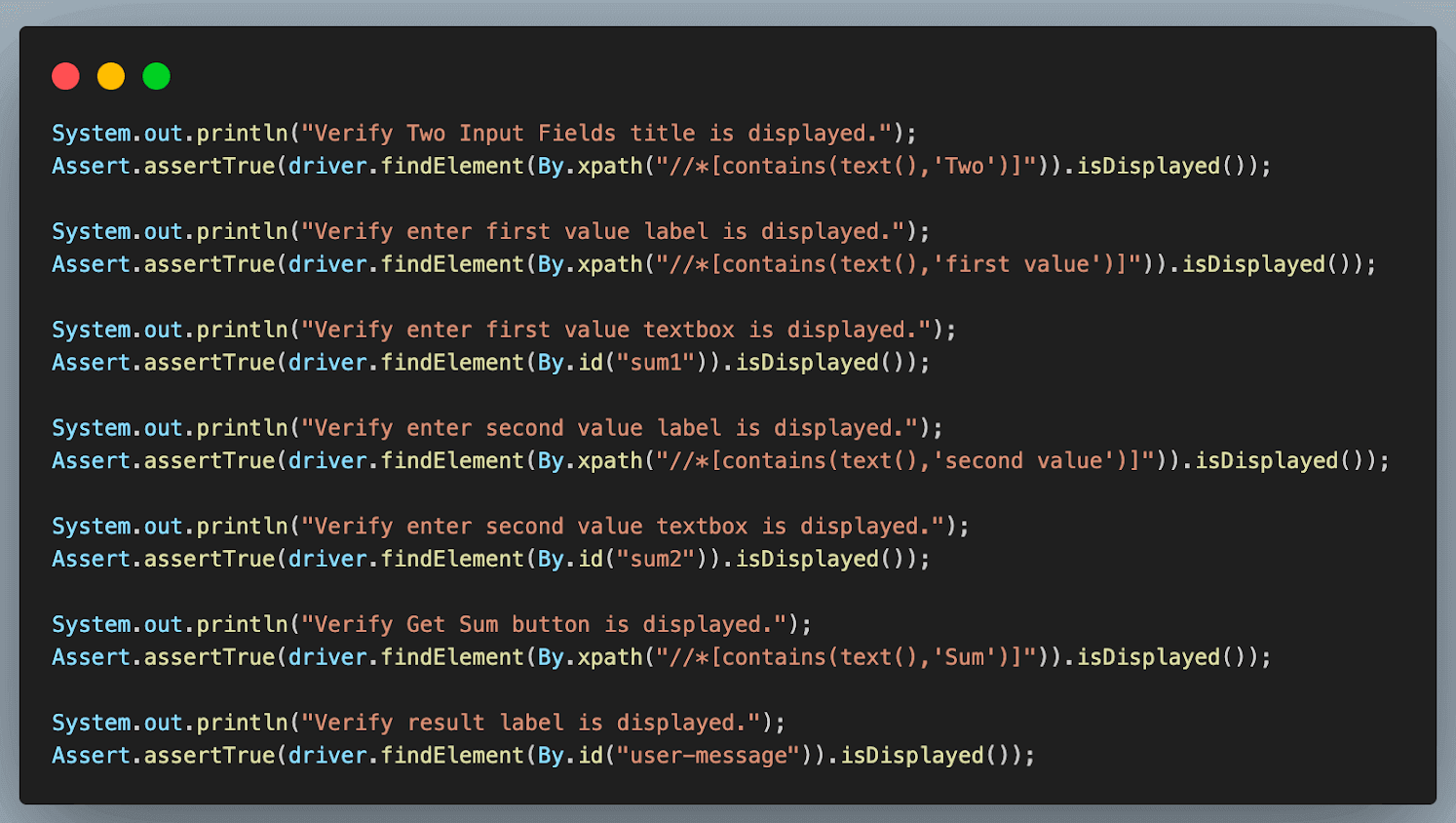
1. Add the second test case as *shouldReturnTheResultWhenBothNumbersAreValid*(). Similar to the previous case, annotate it with the *@Test* annotation and add it to *positiveTest* and *sanity* groups. We have added 2 group names here, unlike 1 in the previous case. This means that this test case in Java will get executed as part of both these groups.

1. Enter the first and second values using the *sendKeys()* method. This method of Selenium WebDriver is used to enter data in any input text box field while working with web automation.
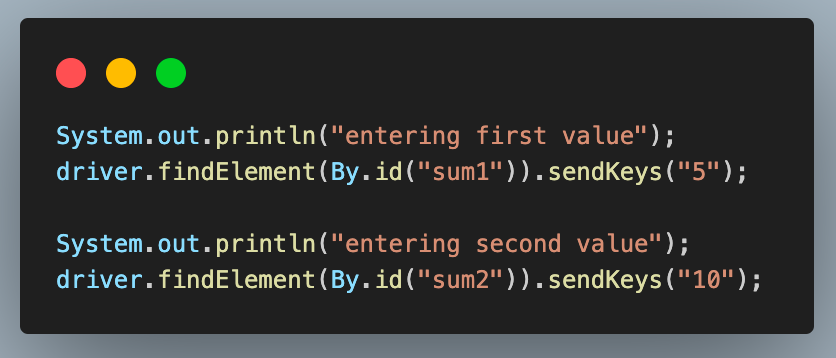
1. After entering the values, click the **Get Sum** button to get the result. For this, another method of WebDriver, *click()* is used.

1. Finally, we fetch the result using the *getText()* method and store it in a variable. This method retrieves any text value from the web page using Selenium web automation. Assert’s a*ssertEquals()* method compares this value with the expected result.

This method is used to compare two values as part of an assertion. Learn how to use asserts in TestNG correctly to help you verify and validate your actual and expected results.
1. Add the last test case and name it as *shouldShowErrorWhenAnyNumberIsMissing()*. Like the previous cases, annotate it with *@Test* and add it to the *negativeTest *and *sanity *groups.

1. Enter any one value using the *sendKeys()* method. Here, we are entering the first value field.

1. Click on the **Get Sum** button.

1. Fetch the error message using the *getText()* method and assert it to be the same as the expected error message using the *assertEquals()* method.

**Test Execution And Results**
Right-click > Select Run As > TestNG, Test to execute the tests individually.
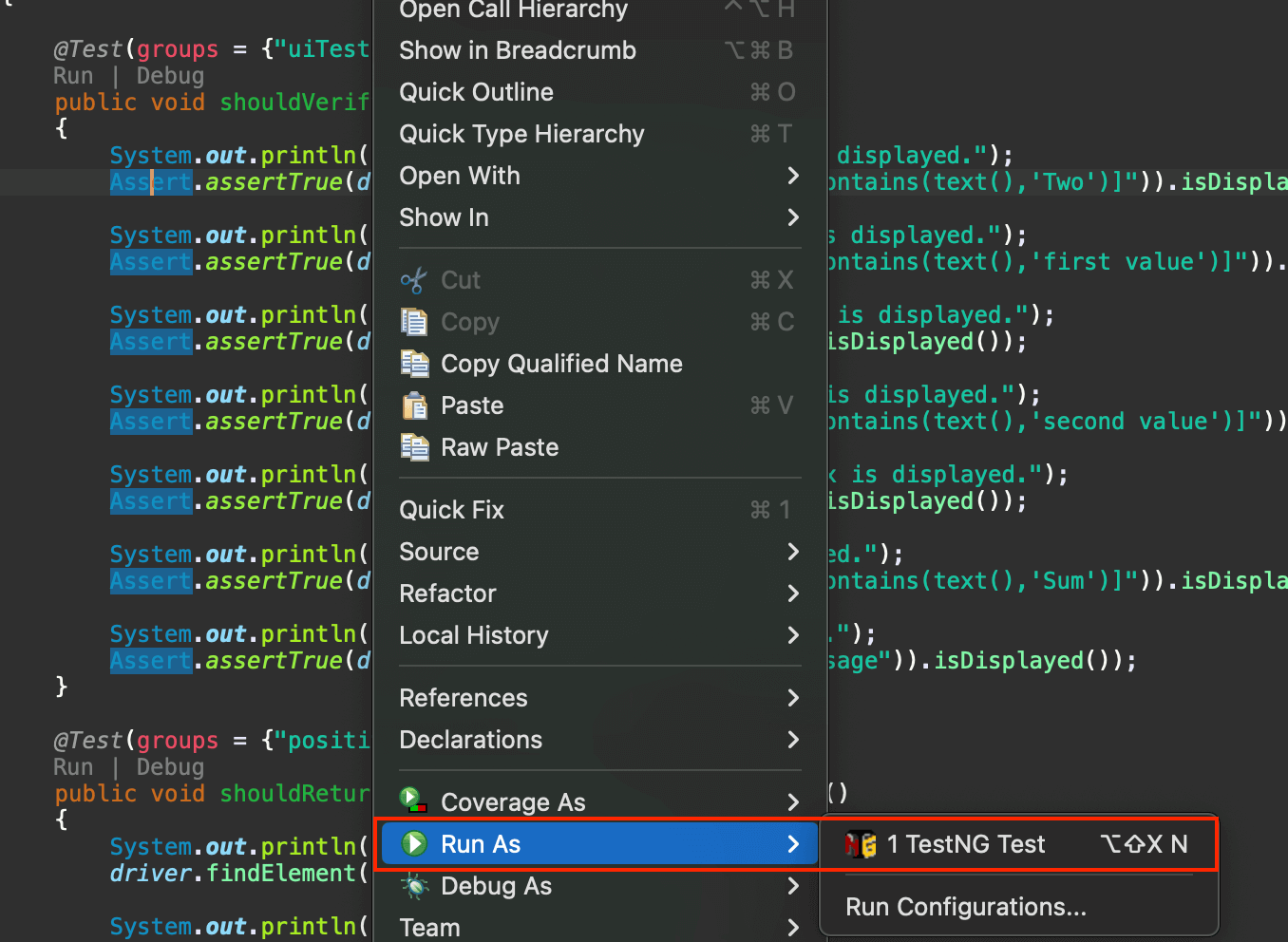
**Result:**
*shouldVerifyAllElementsWhenThePageIsLoaded()*
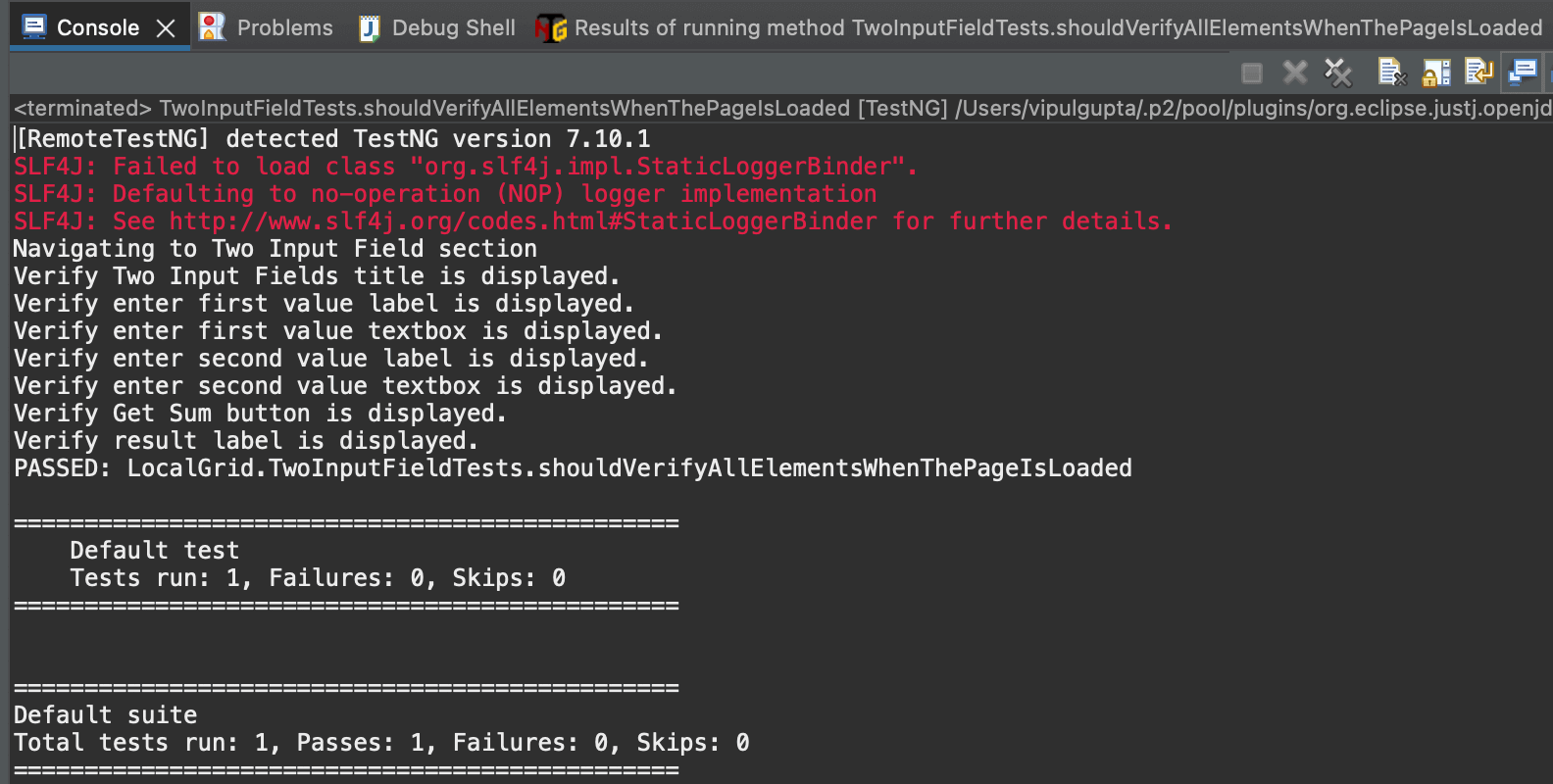
**Result:**
*shouldReturnTheResultWhenBothNumbersAreValid()*
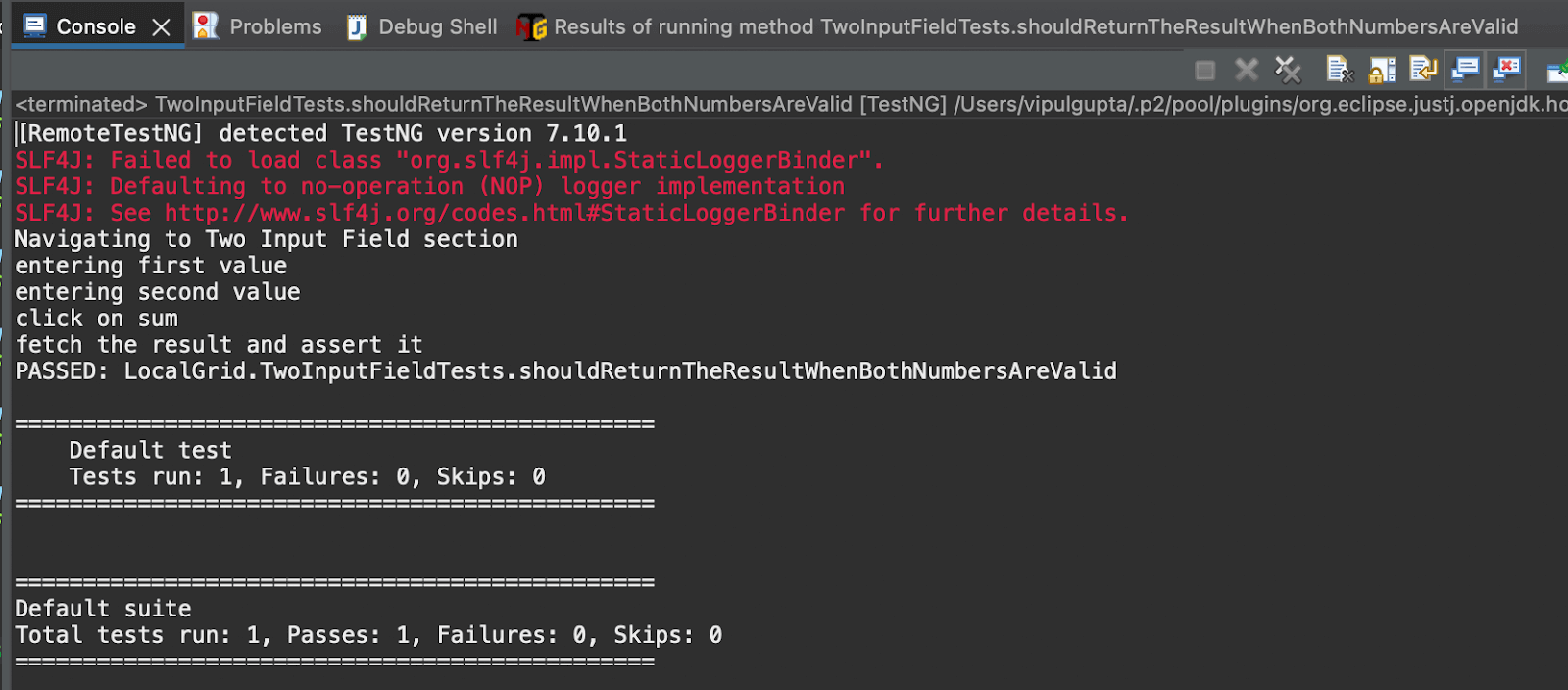
**Result:**
*shouldShowErrorWhenAnyNumberIsMissing()*
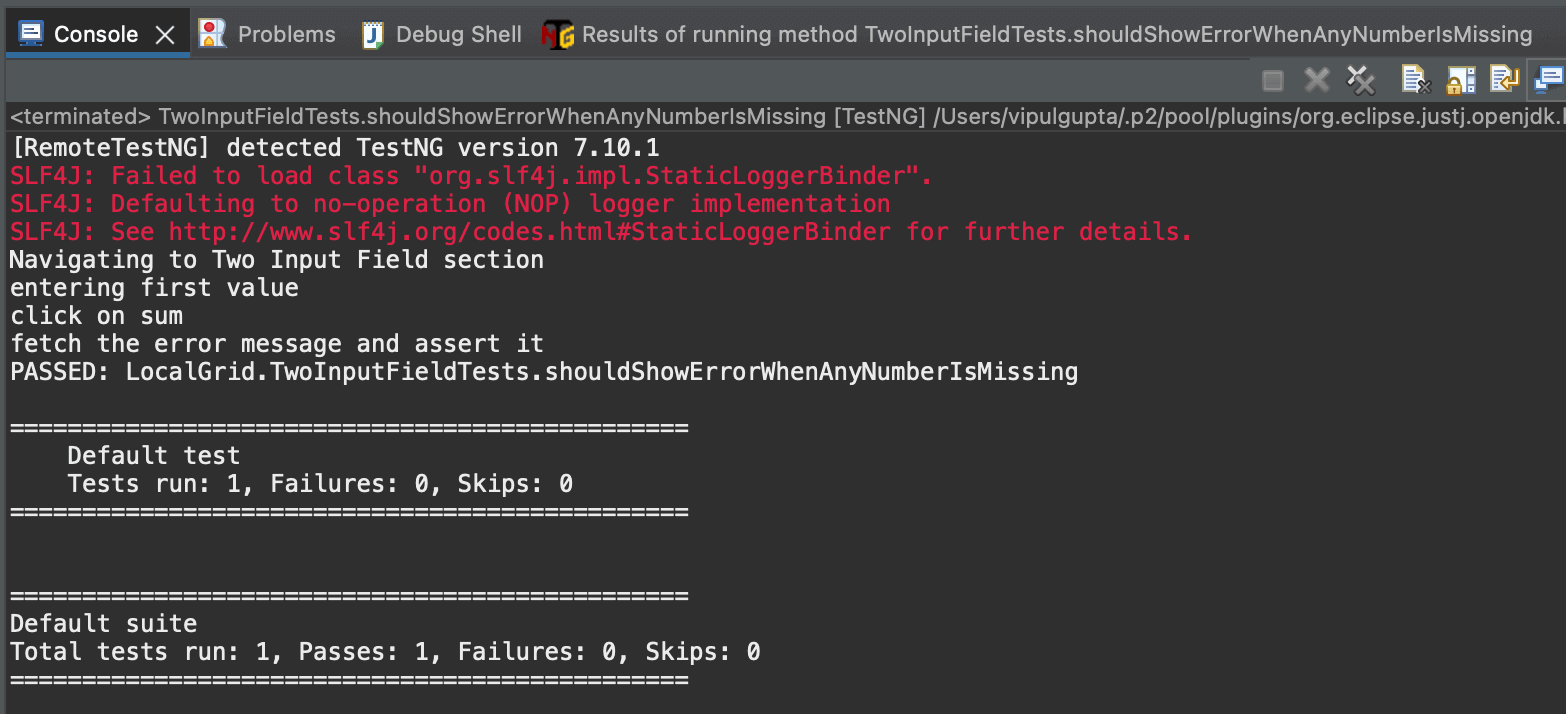
Running tests locally is manageable when working with up to three or four browsers and one operating system. However, this limitation makes it difficult for testers to conduct tests on more than four browsers and multiple operating systems. To address this, testers can use a cloud-based platform where they do not have to worry about maintaining test infrastructure and can conduct comprehensive cross-browser and cross-platform testing seamlessly. One such platform is LambdaTest.
It is an AI-powered test execution platform that lets you run manual and automated [cross-browser testing](https://www.lambdatest.com/cross-browser-testing?utm_source=medium&utm_medium=organic&utm_campaign=aug_12&utm_term=rj&utm_content=blog) at scale, with over 3000+ real devices, browsers, and OS combinations.
This platform provides the speed and resources to make test executions faster and more reliable. It facilitates parallel execution, allowing multiple tests to run simultaneously for large automation suites. This cloud grid platform also offers enhanced logging, maintenance, and debugging resources.
Now, let’s move the local test script to the LambdaTest platform with a few modifications to leverage all the features this cloud grid offers.
## How To Write a Test Case in Java for Cloud Execution?
Having understood the flow of writing and executing the first test case in Java using Selenium and TestNG, let us move ahead and learn how we can do the same on a cloud grid platform.
To use the LambdaTest cloud grid to run the Selenium automation test cases, we need to make some changes to the code to use Selenium *RemoteWebDriver*, which will help connect to the LambdaTest cloud grid and execute the cases over there.
Most of these changes involve configuring the WebDriver settings in BaseTest.java. The modified BaseTest.java with the cloud grid integration will look similar to the example below.
package CLoudGRid;
import java.net.*;
import java.util.HashMap;
import org.openqa.selenium.remote.RemoteWebDriver;
import org.openqa.selenium.chrome.ChromeOptions;
import org.testng.annotations.*;
public class BaseTest {
public RemoteWebDriver driver = null;
String username = System.getenv("LT_USERNAME") == null ? "<lambdatest_username>" : System.getenv("LT_USERNAME");
String accessKey = System.getenv("LT_ACCESS_KEY") == null ? "<lambdatest_accesskey>" : System.getenv("LT_ACCESS_KEY");
String status = "failed";
@BeforeMethod
public void setup() {
try {
ChromeOptions chromeOptions = new ChromeOptions();
chromeOptions.setPlatformName("Windows 10");
chromeOptions.setBrowserVersion("125");
HashMap<String, Object> ltOptions = new HashMap<String, Object>();
ltOptions.put("build", "Test case in Java");
ltOptions.put("name", "Test case in Java");
ltOptions.put("w3c", true);
chromeOptions.setCapability("LT:Options", ltOptions);
driver = new RemoteWebDriver(
new URL("https://" + username + ":" + accessKey + "@hub.lambdatest.com/wd/hub"), chromeOptions);
System.out.println("Navigating to Two Input Field section");
driver.get("https://www.lambdatest.com/selenium-playground/simple-form-demo");
} catch (MalformedURLException e) {
e.printStackTrace();
}
}
@AfterMethod
public void tearDown() {
driver.executeScript("lambda-status=" + status);
driver.quit();
}
}
**Code Walkthrough:** Below is the complete code walkthrough to understand the code written in the above BaseTest.java file. 1. Start by creating required class objects and variables with public access to access them in the test classes. For this, first, create an object of *RemoteWebDriver* and initialize it to null.  1. Next, add the username and access key for your LambdaTest account to connect to the cloud grid for test execution. You can find these in the [Password & Security](https://accounts.lambdatest.com/security) section tab.  1. You can also configure these as environment variables and directly fetch them in code instead of defining them in plain text. **For Windows:** > set LT_USERNAME=LT_USERNAME set LT_ACCESS_KEY=LT_ACCESS_KEY **For macOS and Linux:** > export LT_USERNAME=LT_USERNAME export LT_ACCESS_KEY=LT_ACCESS_KEY 1. Add a String variable as *status* and initialize it with value as *failed*. Before quitting the driver instance, this variable helps mark the test case’s final status as passed/failed on the LambdaTest dashboard. This value is updated to be *passed* in the test case if the test passes with no assertion failures or exceptions. 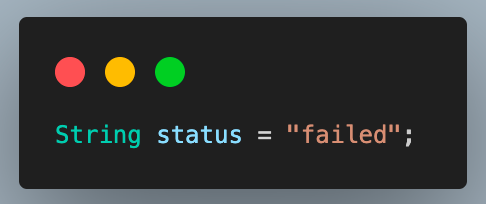 1. Update the code inside the *setup()* method to set the required browser properties and LambdaTest configurations to connect to the cloud grid. 2. Create an object of the *ChromeOptions *class and set the OS and browser versions. 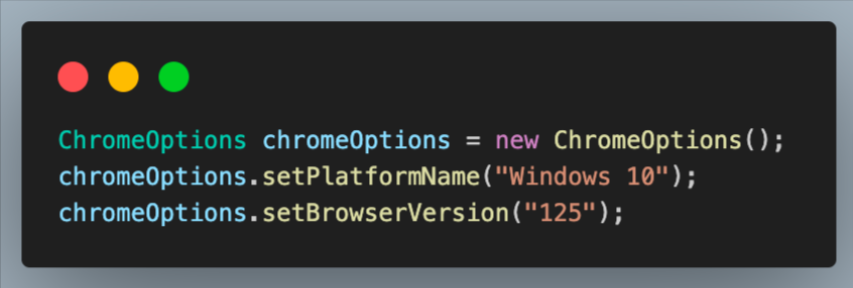 1. Next, create a *HashMap* type variable to specify the additional browser capabilities for the LambdaTest platform. This will help to identify the dashboard test results using the build name and other details.  You can fetch the required browser capabilities from the LambdaTest platform by navigating to the [Automation Capabilities Generator](https://www.lambdatest.com/capabilities-generator/). This helps by offering ready-to-use code for setting up browser capabilities that can be used in execution. 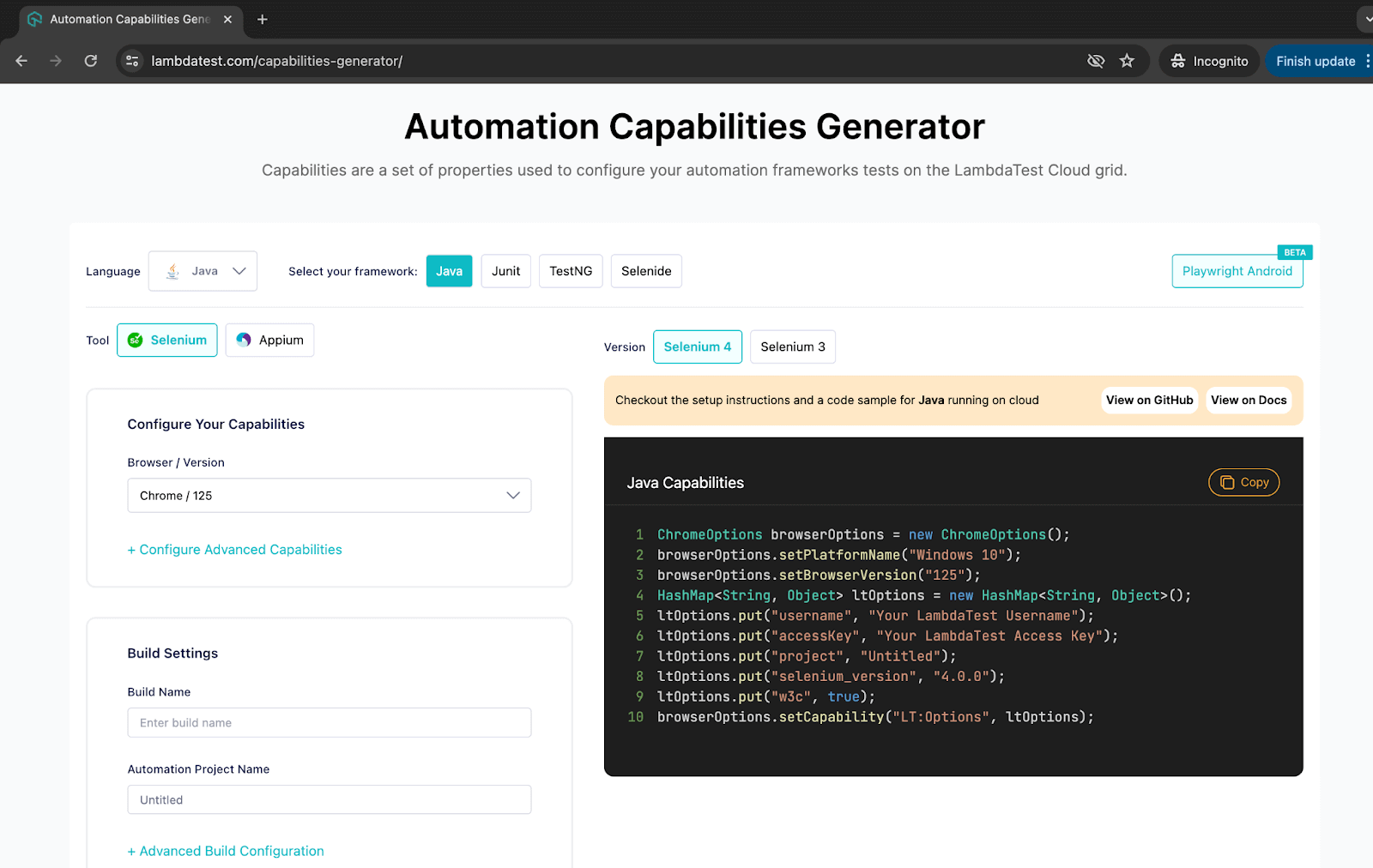 1. Finally, use the Selenium *RemoteWebDriver* to connect to the LambdaTest remote grid using your credentials and *ChromeOptions* class object containing all specified browser capabilities.  1. Use this driver to navigate the Two Input Fields page on the LambdaTest Selenium Playground for test execution.  1. Inside the *tearDown()* method, add a step to execute the script to update the test case status on the LambdaTest dashboard. 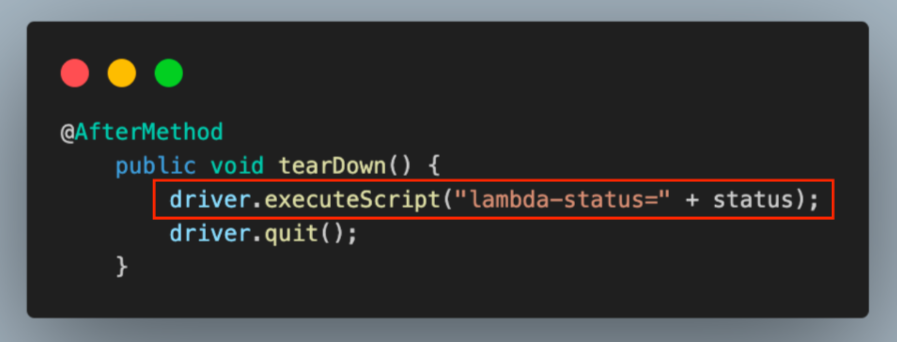 1. Next, move to the test class TwoInputFieldTests.java and add the step to update the status to *passed *after the execution of all test cases. 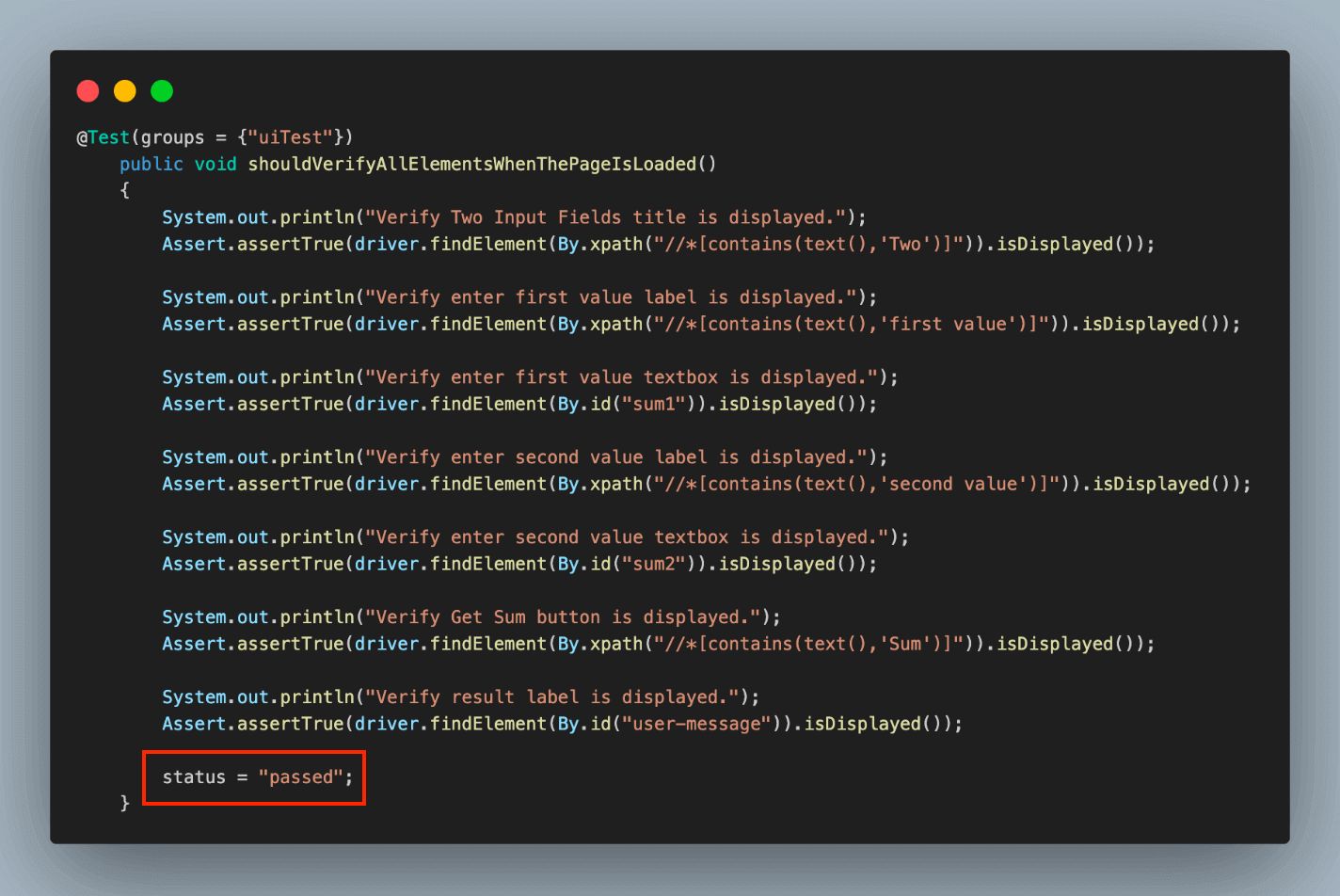 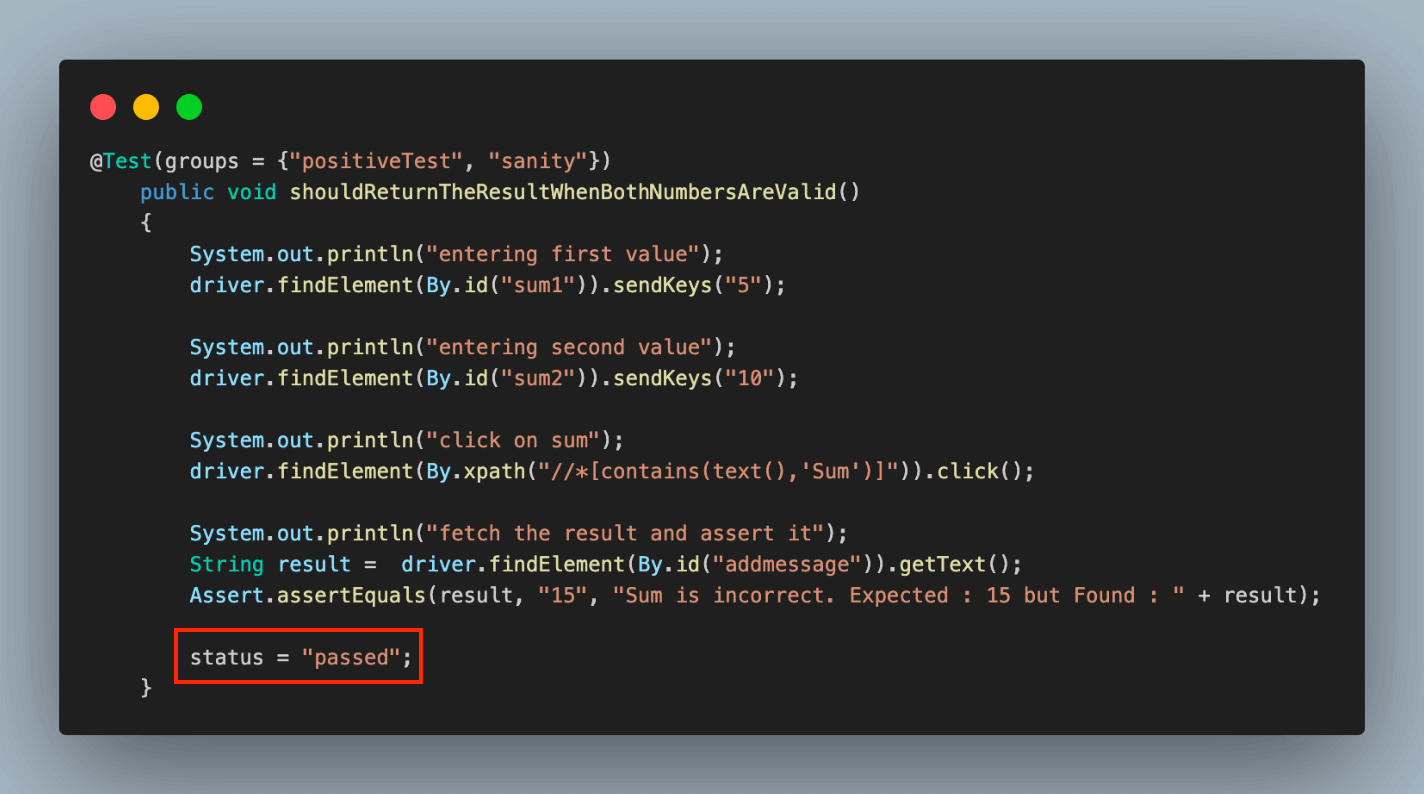 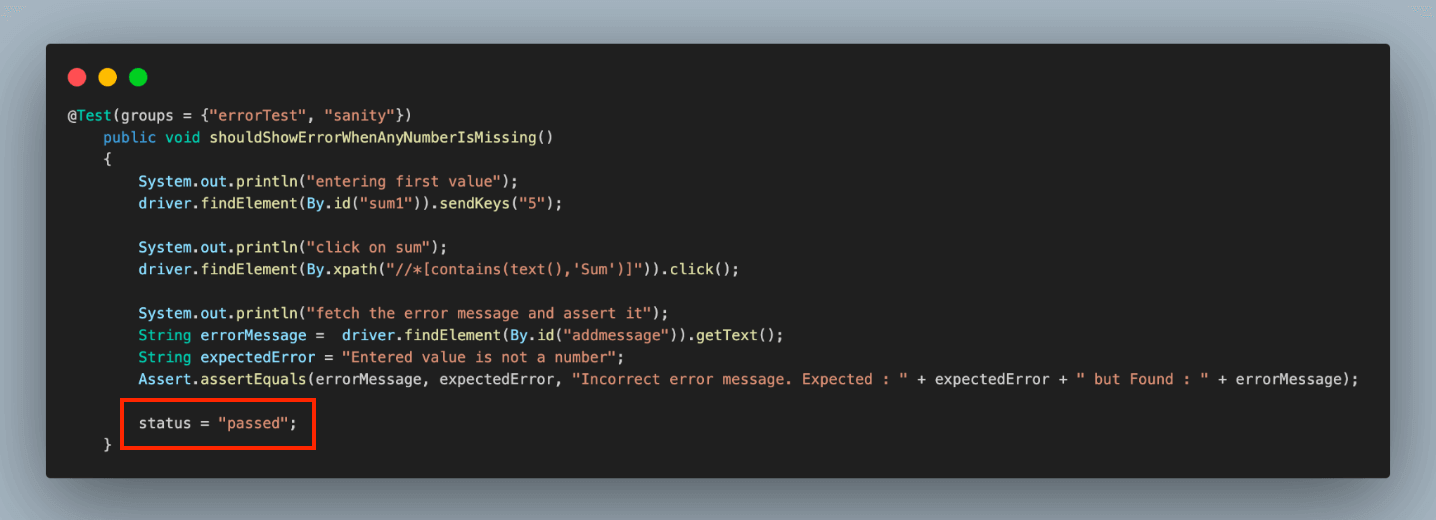 **Results:** We can execute the test cases similarly to how we did for local execution. The console output in the IDE will remain unchanged, but the primary focus will shift to monitoring the execution results on the LambdaTest dashboard. The execution results are on the LambdaTest Dashboard under the **Automation > Web Automation** tab. 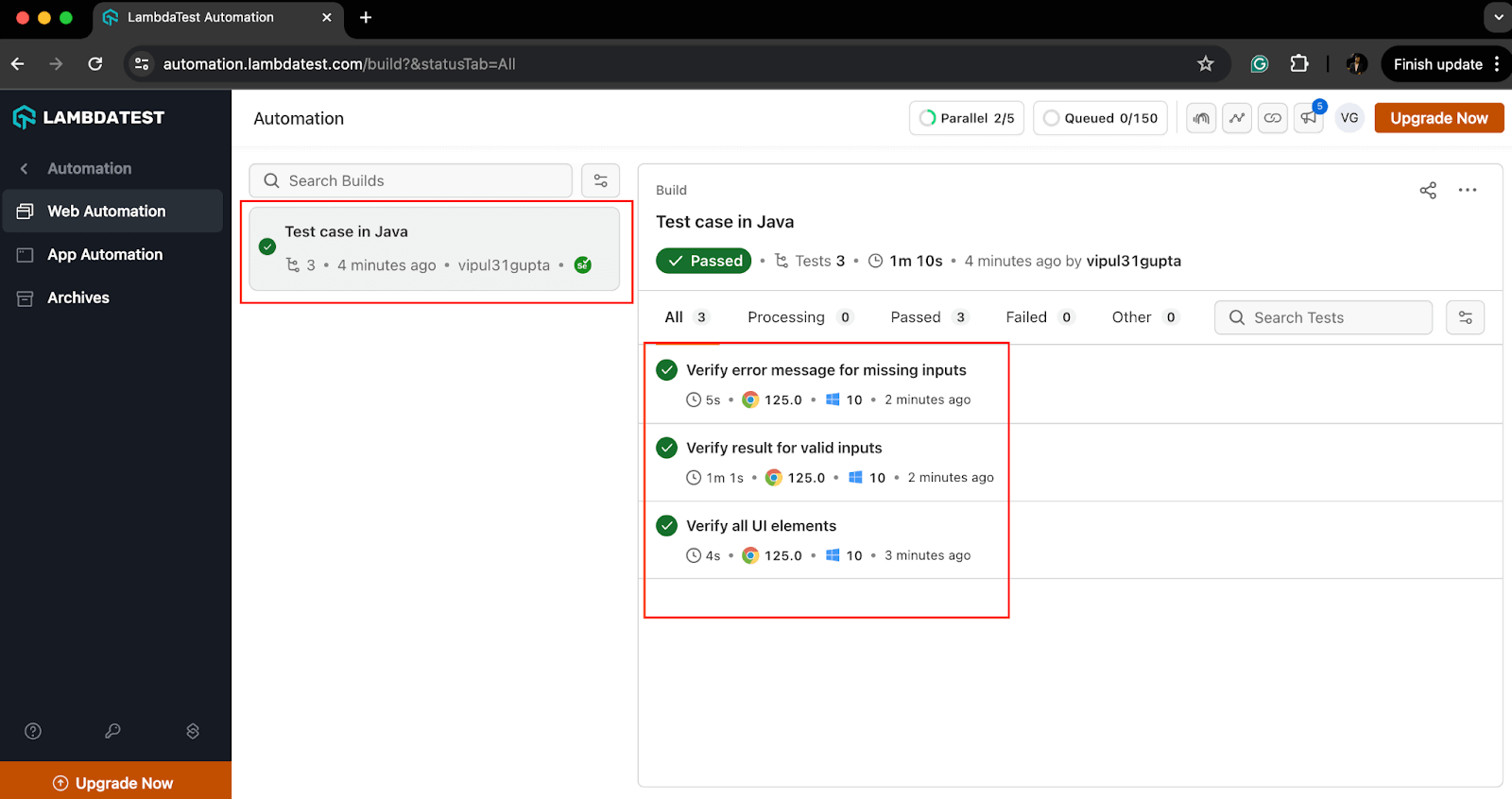 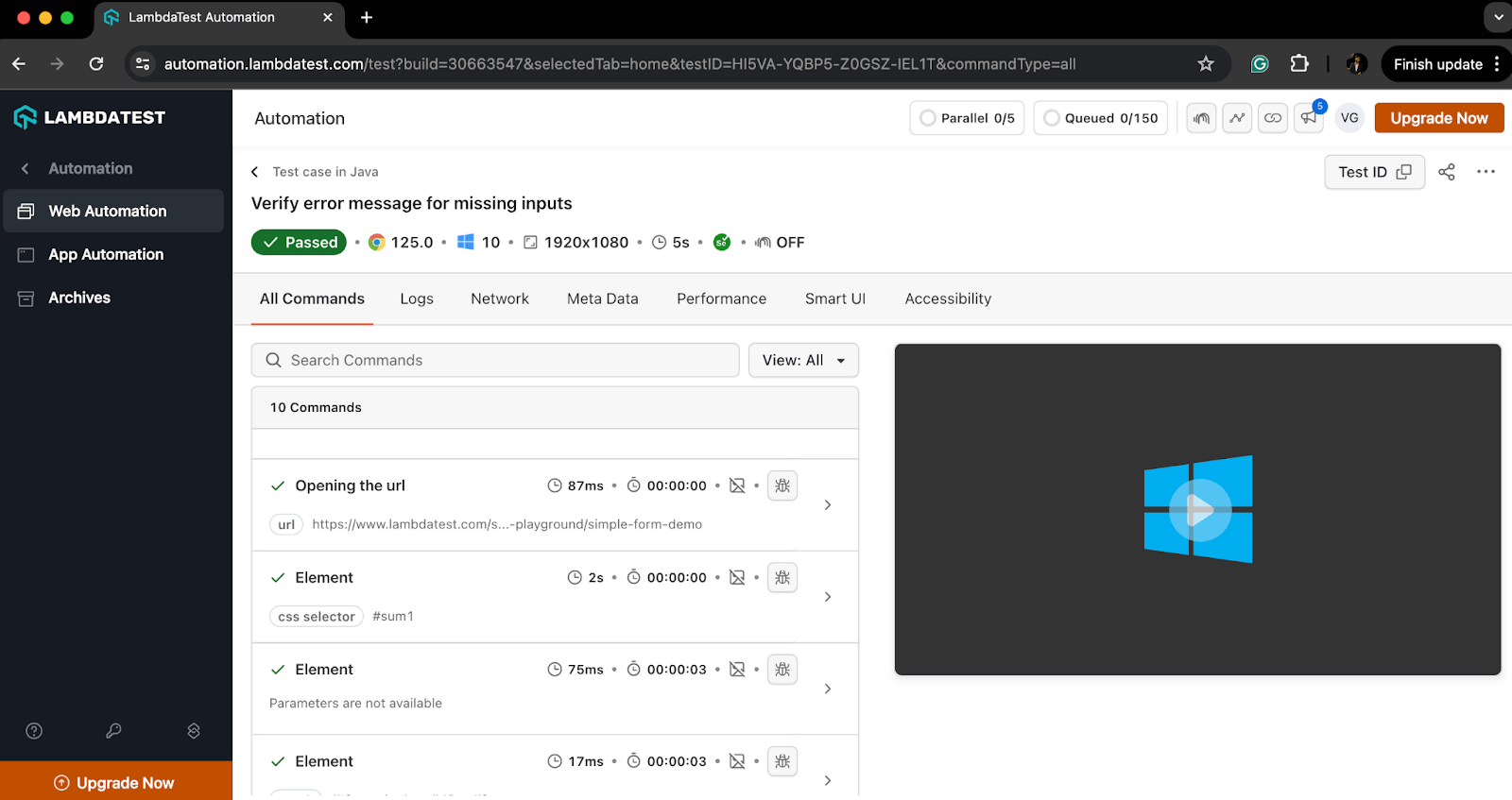 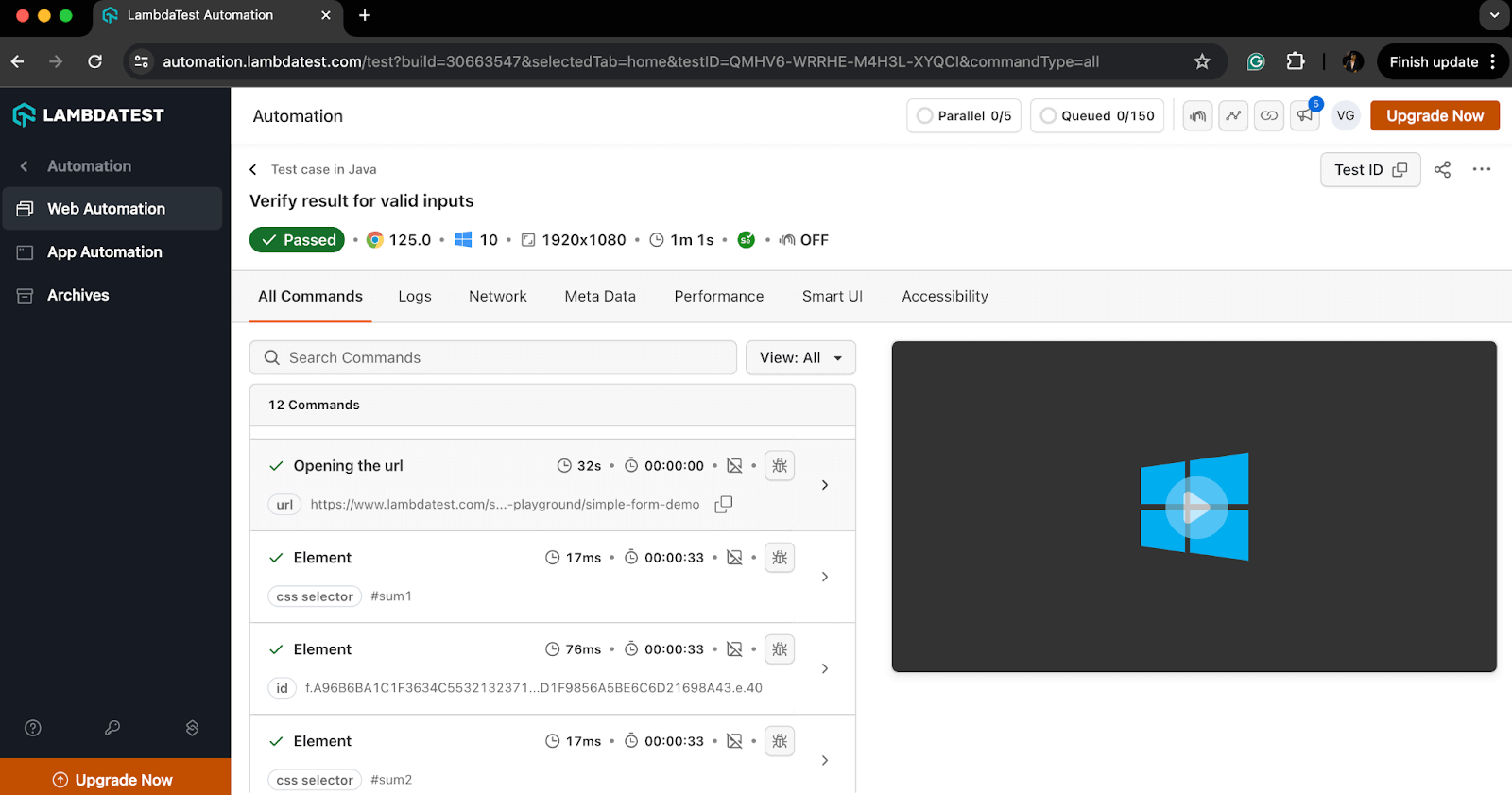 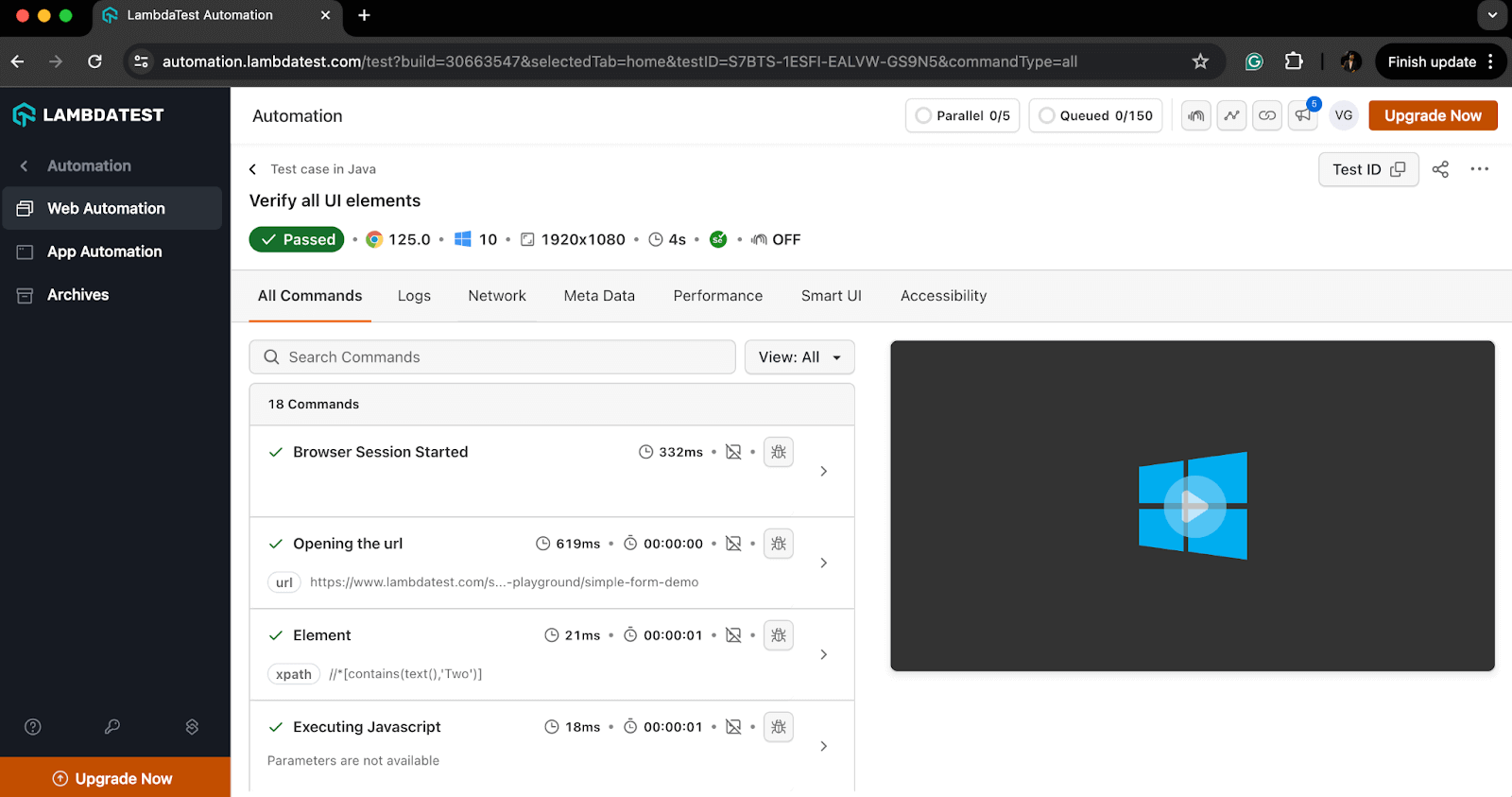 ## Best Practices for Writing Test Cases in Java All the test executions we’ve learned above are written following best practices. Adhering to these practices helps avoid repeating the same or similar mistakes and ensures a smooth test flow in your automation projects. Some of the best practices are given below. * **Understanding the Requirements** The first and foremost requirement of writing a good test case is understanding the changes and features clearly. The tester needs to know what is expected from the code based on the input. We can refer to the product requirement documentation or the acceptance cases to know the expected behavior. * **Maintainable and Reusable Code** The test cases should be readable and follow clean coding principles. This helps to keep test cases maintainable and allows quick refactoring in case of requirement changes without much hassle. * **Clear and Descriptive Test Case Names** The names should be clear and meaningful so that anyone who sees the code or test case can understand what a particular test is supposed to do. The name should be descriptive enough to describe the purpose of the test case. One of the naming conventions one can follow is *should[ExpectedResult*]*When[Condition]*. For example, *shouldReturnTheResultWhenBothNumbersAreValid *or *shouldShowErrorWhenAnyNumberIsMissing*. * **Arrange-Act-Assert Structure** Try to follow the AAA structure for your test cases for effective test management by splitting it into three parts. * **Arrange:** Define and set up the test environment and test data on which we want to execute the test. * **Act:** Write the execution steps which interact with the feature using the above data. * **Assert:** Write proper assertions which verify the actual and expected results. * **One Test Case, One Assertion** Use specific and meaningful assertions for each test case, which helps to verify the required details. One test should not be used to verify multiple flows and should not have a dependency on any other test case. For example, valid results for valid input and error responses for invalid input should be two separate test cases. You can use assertions like *assertEquals(), assertTrue(), assertFalse(), assertNotNull()*, etc., to assert to-the-point data and provide meaningful messages to better understand the failures. * **Using Setup and Teardown Methods** Use *@Before* and *@After* annotations of JUnit or TestNG, depending on your framework, to write setup and teardown methods. These methods help to prevent duplicity by making the common code, like driver setup, browser launch, driver termination, etc, reusable across all the test cases. * **Using Mock Data and Stubs for Error Cases** Mock data or stubs means to simulate a function behavior in the software to return some particular result as desired by the tester to test some particular test cases. We can use mocking frameworks like Mockito or write a stub function to mock dependencies and verify test cases for external dependency failures. * **Covering Edge and Boundary Value Cases** Write test cases to cover all the edge cases or unusual scenarios due to software or hardware downtimes. You can use mocking for such types of test cases. Also, testing for boundary values by passing various test data helps verify if the code and software function properly for limiting cases. * **Using Tags, Groups, and Categories** Use tags, groups, or categories to group the related test cases together that serve some common purpose, flow, or requirement in general. For instance, you can group all test cases for login flow, positive and negative cases, etc. ## Conclusion With this, we have concluded this blog on how to write a test case in Java. In this blog, we learned how a good test case can be written with a basic understanding of Java language and test case fundamentals like flow, assertions, and WeElement locators. We learned the working examples on local and cloud grids and understood how following the best practices makes the test case robust and reliable. Now, it’s time for you to go ahead and try writing your first [test case](https://www.lambdatest.com/learning-hub/test-case?utm_source=medium&utm_medium=organic&utm_campaign=aug_12&utm_term=rj&utm_content=blog) in Java. Happy learning!!
Ce qui précède est le contenu détaillé de. pour plus d'informations, suivez d'autres articles connexes sur le site Web de PHP en chinois!

